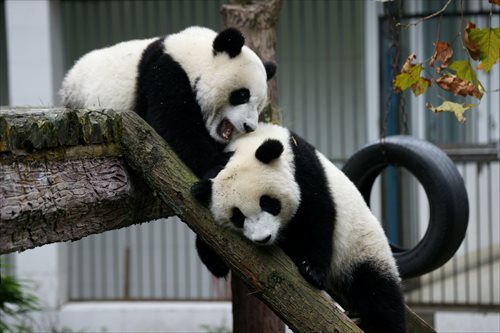HOME >> CHINA
Real kung fu pandas
Source:Xinhua Published: 2016-2-13 19:48:01
Endangered bears taught to fight before being released into wild

Pandas play at a research center in Ya’an, Sichuan Province in 2013. Photo: CFP
In the third installment of the blockbuster DreamWorks franchise Kung Fu Panda our cuddly hero becomes a martial arts master and teacher.
Meanwhile, his real-life, captive-bred cousins are undergoing fight training as part of a program preparing them to survive in the wild.
"We have begun to give a lot of thought to improving the fighting skills of the candidates to go into the wild," said Huang Yan of the China Conservation and Research Center for the Giant Panda.
The wild giant panda population is fragmented into at least 30 isolated groups, each with fewer than 50 animals. This limits mating options as inbreeding could hasten the demise of the species. Captive-bred pandas have been released into the wild since 2006.
These attempts to diversify and bolster the wild population got off to a bad start when the first panda released, Xiang Xiang, a 5-year-old male, died fighting with wild pandas just 10 months after he was set free.
"We know that for a panda to survive in the wild, mere strength is not enough. They need to become really wild, ferocious even, before going to the real, wild world," said Huang.
Start them young
Harsh lessons were learned from Xiang Xiang. His successors now grow up in semi-wild conditions, where fighting skills are cultivated from a very young age.
The conservation center's team have drawn up a pre-release training program for both mothers and cubs that lasts more than two years. Two or three captive-bred cubs join the program each year.
Hua Yan, a 2-year-old female, has gone through the training program. She is the most promising candidate for release this coming spring.
Hua Yan has lived in the wilderness training reserve at Sichuan Province's Tiantai Mountain since her birth in 2013.
"Her mother is her master, of course. Hua Yan learned to walk at about four months. She could climb trees at six months. When she was 1 year old, through cameras in and around feeding sites, we saw that her mother had taught her how to forage for food," said Huang.
Her mother also guided her through mud flows and rock falls. They have survived snow storms and torrential rain together, but improving her fighting was always a priority.
The first step toward becoming a kung fu panda is strength and fitness. Staff set up a jungle gym for Hua Yan, with wooden stands for her to clamber over. She quickly took to climbing as a game.
"We adjusted the height and the structure of the stands as she grew bigger and became more skillful. We constantly pushed her to go higher and faster. We made her stronger," said Huang.
The better part of valor
The first thing that every martial arts practitioner learns is that "He who turns to walk away, lives to fight another day." Learning to avoid enemies is perhaps more important than learning to defeat them in combat. Hua Yan had learned a lot from her mother, but now her human mentors play tricks on her.
In stage two of her training, Hua Yan was taken from her mother to live alone, where staff played her the recorded roars of tigers and bears.
"She showed high vigilance and immediately tried to hide," said Wu Daifu, an expert on panda behavior.
Other animals like wild boars and black bears share Hua Yan's semi-wild enclosure. Fresh dung from other pandas has also been found there.
"This means that Hua Yan actually shares her territory with another panda or pandas. Pandas are generally solitary and have a strong sense of territory. Hua Yan is in good shape now. She is either a survivor or preparing to be one," said Wu.
Planning for trouble
There are some 400 captive-bred pandas worldwide; a sustainable, healthy population.
China plans to train more pandas using the mother-cub process and will release more into the wild, said Huang.
Reintroduction patterns will vary, consisting of releasing cubs alone, releasing mother and cub together and the release of pregnant pandas.
"We are considering new methods of improving their fighting skills too, for example, putting one female in heat and two males together, when a fight will usually happen - pretty much like in the wild," said Huang.
"But we need to be very careful to make sure none of them actually get hurt. There are huge risks. We won't take any bold steps before we're really ready," he said. "It's not only a challenge for the pandas, but for the masters, too."
Posted in: Society